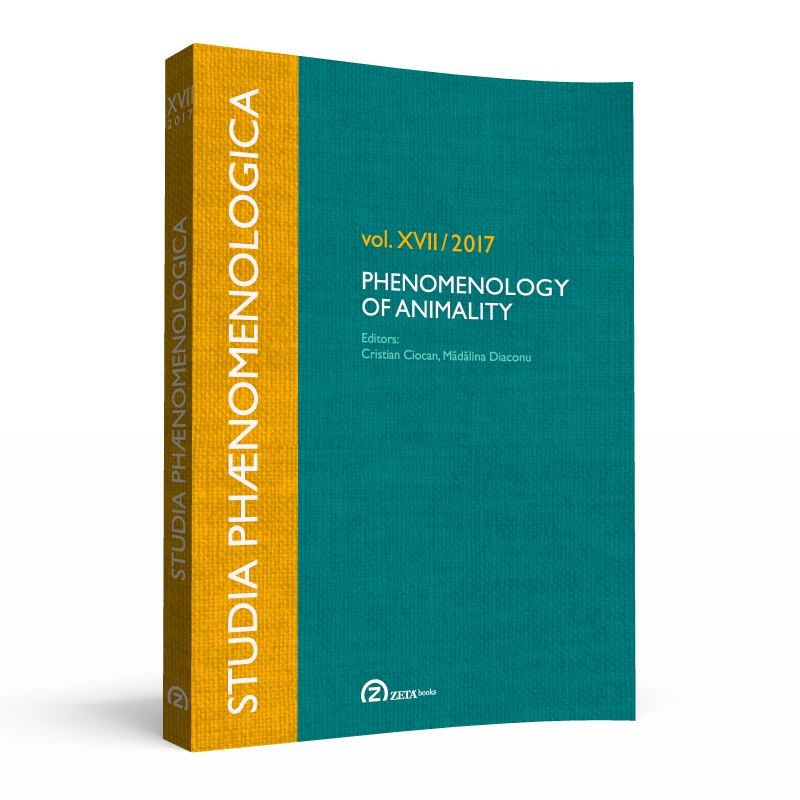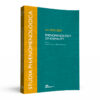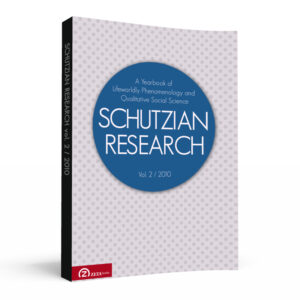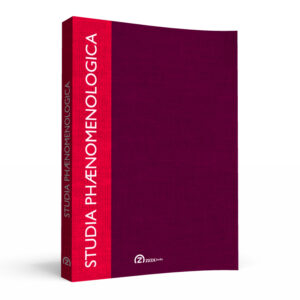PHENOMENOLOGY OF ANIMALITY
Cristian Ciocan, Mădălina Diaconu: Introduction: Phenomenology of Animality. Challenges and Perspectives [OPEN ACCESS]
Maxine Sheets-Johnstone: Husserlian Phenomenology and Darwinian Evolutionary Biology: Complementarities, Exemplifications, and Implications
- Abstract: Descriptive foundations and a concern with origins are integral to both Husserlian phenomenology and Darwinian evolutionary biology. These complementary aspects are rooted in the lifeworld as it is experienced. Detailed specifications of the complementary aspects testify to a mutual relevance of phenomenology to evolutionary biology and of evolutionary biology to phenomenology. Exemplifications of the mutual relevance are given in terms of both human and nonhuman agentive abilities. The experiential exemplifications show that agentive abilities are rooted in the kinetic sequence: I move, I do, I can. The kinetic sequence in turn testifies to an ability to think in movement, a thinking that engenders corporeal concepts. It also, however, attests to the need for a veritable phenomenology of learning on the one hand and for a veritable recognition of mindful bodies on the other, mindful bodies that are a driving force both in the evolution of animate forms of life and in the evolution of repertoires of I cans.
Andreas Beinsteiner: The “As” and the Open: On the Methodological Relevance of Heidegger’s Anthropocentrism
- Abstract: Martin Heidegger distinguishes the human—as a world-forming, historical being that is capable of language—from the animal, which, according to him, is poor in world, ahistorical and incapable of language. This clear-cut distinction, which is connected to Heidegger’s anti-biologism, has frequently been criticized. By discussing the criticism of Matthew Calcaro, Giorgio Agamben and Jacques Derrida, the present paper aims to show that in Heidegger (1) the human-animal difference is not a biologically determined distinction, (2) human language is not (primarily) understood as an instrument of expression and communication, and (3) humans are not distinguished from animals on the basis of their supposed access to an “objective” reality. While all three points imply corrections to the reception of Heidegger in animal philosophy, (3) is particularly crucial since it refutes Derrida’s interpretation of the as-structure, which has had a large influence on readings of Heidegger, also far beyond the topic of animality. Taking into account these clarifications, a specific historical response-ability of the human becomes intelligible that is relevant in particular in regard to ethical aspirations in animal philosophy.
Tommy Andersson: Otherworldly Worlds. Rethinking Animality With and Beyond Martin Heidegger
- Abstract: By setting up a dialogue with contemporary animal research the essay attempts, on the one hand, to expose the limits of Martin Heidegger’s concept of animality in The Fundamental Concepts of Metaphysics, and, on the other hand, to propose some new ways of thinking the being of those animals that most distinctly show themselves as being other than Heidegger’s claims. I suggest, with reference to Heidegger’s thesis of the animal as “poor in world,” that the being of the cognitively most complex animals is better understood in terms of otherworldly worlds within the world of human world forming. With this concept I aim to develop and continue, rather than criticize, Heidegger’s way of thinking the being of animals and deepen the productive relationship between science and philosophy that Heidegger proposed in this work.
Frank Shalow: Animal Welfare, the Earth, and Embodiment: Transforming the Task of Hermeneutic Phenomenology
- Abstract: The attempt to appropriate Heidegger’s thinking in order to found environmental ethics continues to pose challenges both for understanding the premise of an ethic, and, conversely, for unfolding the importance of his thought in the effort to displace the anthropocentric focus of modern philosophy. These challenges must be taken up on a methodological as well as a thematic level, in order to show how a claim of being can implicate a reciprocal guidance pertaining to our treatment of the earth, nature, and animals. An appeal to the ethos of situated dwelling is not sufficient to ground a trans-human ethic; rather, a precursory step must be taken to uncover a common space of embodiment, thereby marking a jointure whereby habitats fostering the potential for animals to “flourish” can be cultivated in concert with our own capacity to dwell. When viewed through this prism of our “incarnality,” the stewardship that we practice in dwelling on the earth can also “formally indicate” a sense of proportionality, e.g., a “measure,” counter balancing the interests of animals with humans. Conversely, the search for a trans-human ethic calls for a further transformation of phenomenology through its interface with hermeneutics.
Christian Sternad: Being Capable of Death. Remarks on the Death of the Animal from a Phenomenological Perspective
- Abstract: In this article, I investigate how phenomenologists have analysed the relation between man and animal with respect to death. The common tendency of most phenomenologists is to grant man a specific mode of being and to attribute a parallel but deficient mode to the animal. In this way, phenomenology fails to accomplish a positive phenomenological description of the animal’s mode of being or of animality as such. I turn to Heidegger’s decisive analysis of human/animal death since Heidegger would constantly hold on to the idea that the animal, in contrast to man, has no explicit relation to death and is therefore not capable of death as death. This leads to his very provocative claim that only man “dies” whereas the animal just “perishes.” Hence, the problem of the man/animal-relation becomes a very distinct problem in relation to death since death concerns the very way in which a certain form of being relates to the world. I aim to shed light on the genesis of the problem in order to put the question of the animal’s death in a proper perspective. I argue that it is precisely death where phenomenology loses its firm grip on the differentiation between man and animal and hence it is this distinction that has to be put back into question.
Simona Bertolini: Ist der Mensch auch ein Tier? Zwei Antworten der phänomenologischen Tradition
- Abstract: The phenomenological interpretation of the human being is not a naturalistic explanation. Likewise phenomenology does not interpret the human being as an example of a complex animal: from a phenomenological point of view man is not an animal, inasmuch as his definition and his essence imply a specifically human component, which cannot be attributed to the linear development of animal complexity. However, this does not mean that any animal component is excluded from the structure of humans. How can human animality be acknowledged without denying human specificity and upholding a reductionist view? The purpose of the paper is to analyse and compare two different ways in which the phenomenological tradition has answered this question.
Lucia Zaietta: La première personne en biologie : passion et révolution. Repenser la subjectivité animale à la lumière de la dimension pathique
- Abstract: Animality is a central issue in phenomenology. If the core of the phenomenological approach is the investigation into the correlation between subject and object, what are we talking about when we talk about animal subjectivity? Is it possible to include the notion of animal being in the category of subject? What kind of intentionality does it possess? Our article will analyse the pathic dimension in order to track down some indications about animal subjectivity. Particular emphasis shall be placed on Weizsäcker and Merleau-Ponty’s perspectives. Both call into question the definition of subjectivity as an absolute and neutral gaze, exclusively attributed to human being. By contrast, by analysing sensitivity as the common background between animal and human beings, it will be possible to introduce the subject into biology, as explicitly stated by Weizsäcker. Subjectivity lies at the intersection between passivity and activity, between perception and movement, between passion and revolution.
James Mensch: The Animal and the Divine: The Alterity that I Am
- Abstract: Even a quick look at the history of religions leaves one impressed with how often the animal has been taken as a manifestation of the sacred. Another feature, frequently found, is the emphasis on the transcendence of the divine. Its radical alterity is such that we cannot directly encounter it. What is the alterity, the transcendence that conjoins these features? In this article, I argue that this alterity is that of the unconscious. Two types of impulses spring from it: impulses that we symbolically project as the Eros rooted in our animal, embodied existence and impulses that we project as springing from the divine. The only way that we can form a stable representation of ourselves is through the intertwining of both of them. Such an intertwining can be accounted for by means of Merleau-Ponty’s model of reversibility and mutual disclosure.
Corry Shores: What Is It Like To Become a Rat? Animal Phenomenology through Uexküll and Deleuze & Guattari
- Abstract: We respond to a phenomenological challenge set forth in Thomas Nagel’s “What Is It Like To Be a Bat?,” namely, to seek a method for obtaining a phenomenological description of non-human animal experience faithful to an animal’s first-person subjective perspective. First we examine “translational” strategies employing empathy and communication with animals. Then we turn to a “transpositional” strategy from Uexküll’s Umwelt theory in which we objectively determine the components of a non-human animal’s subjective world of experience and then map those coordinates onto our own subjective world. While this method gives us partial access to the animal’s “perception-world” aspect of its Umwelt, it does not inform us about what it is like to live in the interactive, “effect-world” aspect. To better overcome this limitation, we add a “transformational” approach derived from Deleuze’s & Guattari’s notion of “becoming-animal,” in which we take on an animal’s manners and capacities for interacting with the other objects and creatures in its world.
Jean-François Perrier: De la phénoménologie à l’éthique animale. Subjectivité et animalité chez Jacques Derrida
- Abstract: The goal of this article is to demonstrate that, following Derrida, in order to develop a theory of animality it is necessary to renounce to the implicit use of concepts related to subjectivity (such as “ego,” “ipse,” or “Dasein”). The deconstruction of subjectivity is thus the only way to establish an ethical requirement concerning animals, a requirement which is no longer conceived from the point of view of our “humanity.” In the first part of the paper, I attempt to locate Derridean ethics within phenomenology in a way which situates ethics in relation to the experience of aporia. In the second part, I focus on what Derrida calls the “carnivorous sacrifice” and try to outline a concretization of the ethics of hospitality and of responsibility that reconfigures our relationships with animals.
Orietta Ombrosi: “Stealthy as a wolf” toward the wolves
- Abstract: By drawing on Jacques Derrida’s analysis of the animal question in his last seminars entitled The Beast and the Sovereign, I approach the possibilities of fraternity not only among beasts, between “the wolf and the lamb,” but also between them and humans, in terms of their differences. More precisely, while illustrating certain limits of his analysis, I look at his decisive inquiry concerning “the animal,” which goes hand in hand with political inquiry. Yet we take this path in the company of the wolf, the metaphorical wolf, and following the French expression “à pas de loup” (“stealthy as a wolf”) as used by Derrida, in order to deconstruct the very concept of sovereignty (symbolized also by the wolf) and thus to think of politics beyond politics or otherwise than politics. However, I also bring in Levinas, almost a “wolf” waiting along the way, to demonstrate how, despite Derrida’s vast work on these questions, he remains imprisoned in what he wishes to deconstruct, as if he were not completely able to extract himself from it.
Galit Wellner: Do Animals Have Technologies?
- Abstract: The question of whether animals have technologies is studied in this article in three genealogical steps according to the development of human technologies: tools, machines and digital technologies. In the age of tools animals were regarded as lacking technologies. In the age of machines, observations in animals show tool usage. However Marx attributes both machines and tools only to humans in order to avoid a break between premodern humanity that had only tools to modern humanity that invented and used machines. In the age of digital technologies animals have been observed using and inventing tools as well as complex technics like language and agriculture. These genealogical steps conform to Calarco’s mapping of animality into identity, difference and indifference, which allow us to think of not only the identity between humans’ and animals’ technologies but also of the differences.
VARIA
Thomas Byrne: The Dawn of Husserl’s Pure Logical Grammar: Husserl’s Study of Inauthentic Judgments from “On The Logic Of Signs” as the Germ of the “Fourth Logical Investigation”
- Abstract: This paper accomplishes two goals. First, I elucidate Edmund Husserl’s theory of inauthentic judgments from his 1890 “On the Logic of Signs (Semiotic).” It will be shown how inauthentic judgments are distinct from other signitive experiences, in such a manner that when Husserl seeks to account for them, he is forced to revise the general structure of his philosophy of meaning and in doing so, is also able to realize novel insights concerning the nature of signification. Second, these conclusions are revealed to be the foundation of Husserl’s pure logical grammar, found in the 1901 “Fourth Logical Investigation.” In his analysis of inauthentic judgments, Husserl already recognized, albeit in a problematic way and for entirely different reasons, many of the central tenets of the 1901 work concerning categoremata and syncategoremata, matter and form, and the isomorphism between them.
Luis Román Rabanaque: Dorion Cairns’ Contributions to a Phenomenology of Animism
- Abstract: The aim of the present paper is to advance some considerations on the question of animism from a phenomenological perspective. Firstly, we deal with the problems of the access to the phenomenon, and of its interpretation on the part of contemporary anthropology. Both problems are connected with the gap which seems to exist between so-called primitive, animistic societies, and so-called civilized, scientific cultures. Secondly, since Husserl does not devote specific analyses of this issue, we address Dorion Cairns’ methodology and concrete investigations. Our major claim is that his reflections, largely inspired by Husserl’s notion of sense-transfer (Sinnesübertragung), may provide a better understanding of the gap mentioned above and perhaps a way to overcome it by disclosing a genetic common root not only of animistic and modern mentalities, but also of pantheism and theism. A final section is devoted to Husserl’s scattered considerations on the subject which might throw additional light on Cairns’ claims.
Claude Romano: L’énigme du « Selbst » dans l’ontologie fondamentale heideggérienne
- Abstract: What does the ostensibly innocuous phrase “das Selbst” (the self) exactly mean in Heidegger’s fundamental ontology? Does Heidegger really have a « theory of the self » in the same way as, say, Descartes, Locke or Husserl? This is what has been often concluded by many interpreters of Being and Time, and it is that view that the current paper attempts to challenge. Heidegger not only rejects the supposition of a substantial ego, along the lines of Descartes’ conception, but he also repudiates any “self: understood as a present-at-hand being, a inner core of Dasein, and he insists on the intrinsic connection between the “egologies,” from Descartes to Husserl, and « traditional ontology ». What seems to be at stake in the fundamental-ontological approach of Sebstheit and Selbstsein, Being-oneself, is rather a complete paradigm-shift, since both concepts refer to “ways of being” or “ways of existing” of Dasein, and no longer at all to a self-identical being of a condition of its self-identity. In trying to investigate the economy of the related existential concepts of Jemeinigkeit, Selbstheit and Man-selbst, this article makes the claim that Heidegger’s break with egology is much deeper that it has been often thought, and that the phenomenologist raises a completely new question, rather than trying to give a new response to older ones.
Roberto Terzi: Être, histoire, écriture : Derrida lecteur de Heidegger
- Abstract: The aim of this paper is to highlight the main features of Derrida’s interpretation of Heidegger in his 1964–65 lecture series Heidegger: la question de l’Être et l’histoire. Taking the issue of historicity as the main interpretive thread, the paper argues that, in Derrida’s view, Heidegger’s position constitutes a significant progress with regard to mainstream philosophical tradition. For Heidegger, historicity is originary and non-ontic; conceiving of it in this way enables us to overcome the primacy of the present and the subjectivist metaphysical approach which authors such as Hegel and Husserl still display. The paper then reconstructs Derrida’s critique of the chapter on the historicity of Dasein in Being and Time, as well as his approach to the history of Being through the topic of the metaphor. The critical force of this reading will be supported by an analysis of some of Derrida’s later writings, which also enable us to sketch some possible avenues for future research, in particular on the relationships between writing and history and on Heidegger’s concept of Versammlung.
Vincent Blok: Realism without Speculation: Heidegger, Meillassoux and the Question of Philosophical Method
- Abstract: In this article, we evaluate Meillassoux’s criticism of correlationism in general and of Heidegger’s correlationism in particular. Contrary to earlier contributions, we argue that Meillassoux’s reflections on uncorrelated being not only serve an epistemological but also an ontological interest; both Meillassoux and Heidegger are interested in the way we have access to uncorrelated being as well as in the nature of uncorrelated being itself. After introducing Meillassoux’s criticism of the correlationism of Heidegger, we reflect on three arguments of his account of planet earth as un-correlated being; the emergence of planet earth, the presupposed accessibility of un-correlated being and his criticism of Heidegger’s fideism. Although it becomes clear that Meillassoux’s criticism of correlationism is not applicable in the case of Heidegger, it also helps us to articulate the relevance of Heidegger’s “realist” approach of uncorrelated being in contemporary philosophy.
Benjamin Delmotte: Pour une phénoménologie de l’évidence esthétique
- Abstract: If the idea of a phenomenological aesthetic evidence is far from being obvious, it may yet become necessary in the description of the aesthetic experience. For the way a work of art can imperiously impose on the viewer reveals a kind of power that may suggests that this evidence is more than just a subjective feeling. Although Husserl’s phenomenology doesn’t consider such an evidence, and although this concept may even be regarded as a contradiction—since evidence particularly characterizes the givenness of perceptive objects—we may yet find the conditions of possibility of such an aesthetic evidence in Husserl’s work.
BOOK REVIEWS
Mădălina Diaconu: Hermann Schmitz, Atmosphären (Freiburg/München: Karl Alber, 2014)
Alexander Schnell: Claudia Serban, Phénoménologie de la possibilité. Husserl et Heidegger (Paris: PUF, 2016)
Alexandru Bejinariu: Dieter Lohmar, Denken ohne Sprache. Phänomenologie des nicht-sprachlichen Denkens bei Mensch und Tier im Licht der Evolutionsforschung, Primatologie und Neurologie (Dordrecht: Springer, 2016)
Christian Sternad: Michael Staudigl, Phänomenologie der Gewalt (Dordrecht: Springer, 2014)
Andrei Simionescu-Panait: Florence Burgat & Christian Sommer (éd.), Le phénomène du vivant. Buytendijk et l’anthropologie philosophique (Genève: Métis Presses, 2016)
Cătălina Condruz: Jason W. Alvis, Marion and Derrida on the Gift and Desire: Debating the Generosity of Things (Dordrecht: Springer, 2016)
Mădălina Diaconu: Hartmut Rosa, Resonanz. Eine Soziologie der Weltbeziehung (Berlin: Suhrkamp, 2016)






